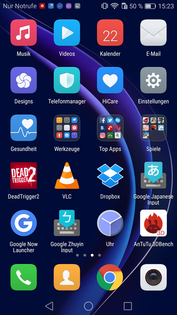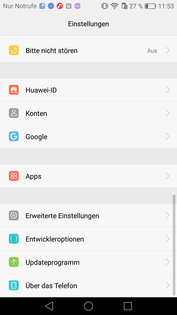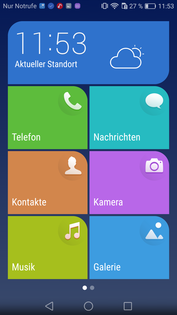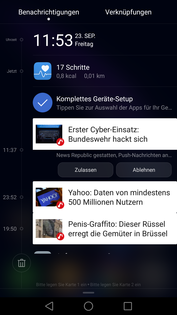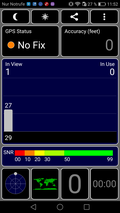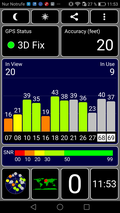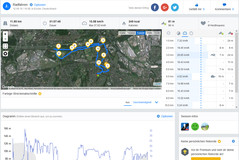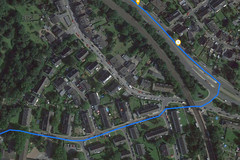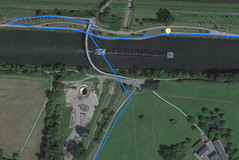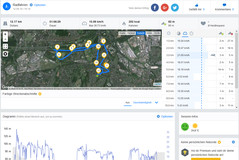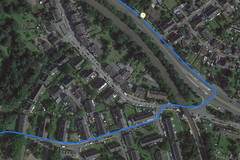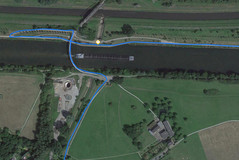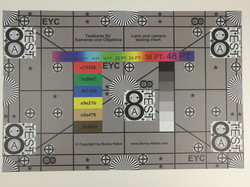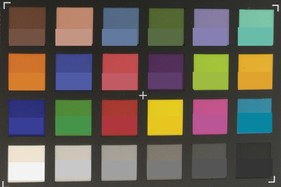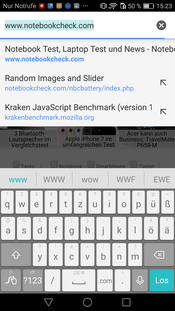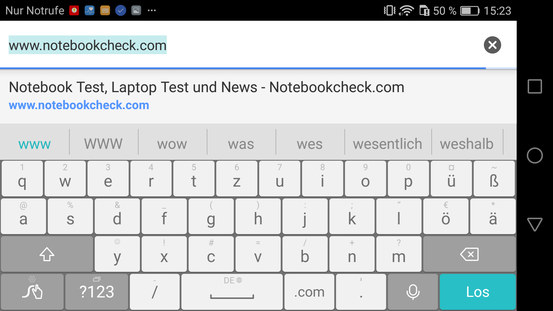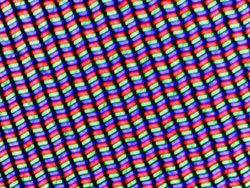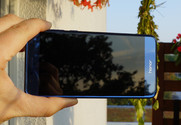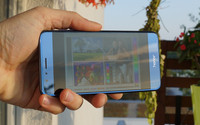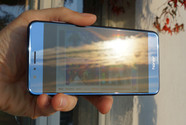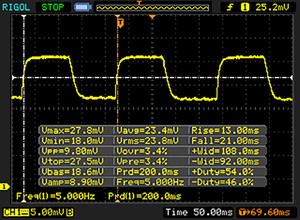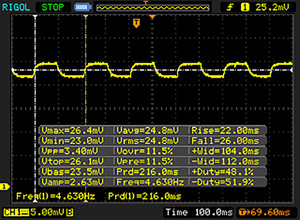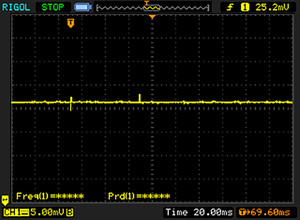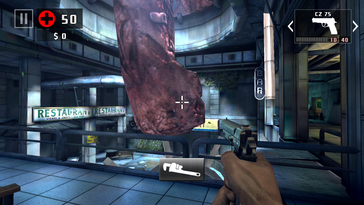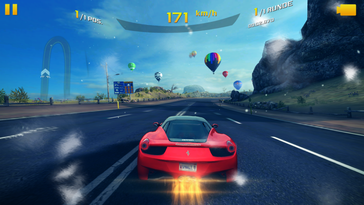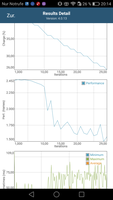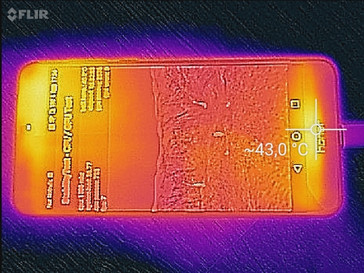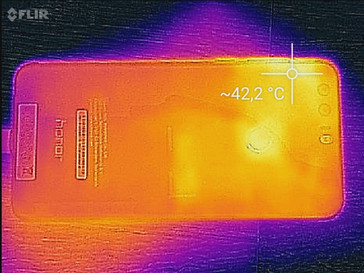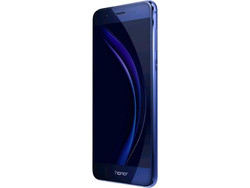Honor 8 Smartphone Review
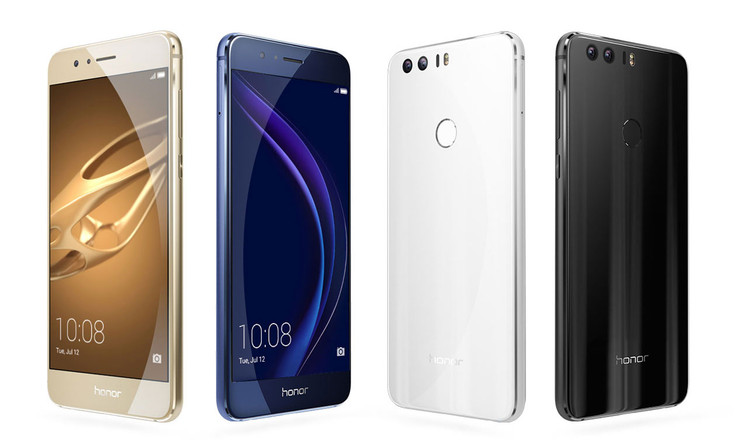
For the original German review, see here.
Honor has sent a very good-looking smartphone to our test lab: Honor's 8 with a very narrow display bezel on the sides and a back cover that plays with light reflections is definitely an eye-catcher. It has to be, seeing that its price range is highly competitive. Since OnePlus' One has established high-end components in the 300 to 400-Euro (~$336 to ~$449) price range, more and more manufacturers are launching great handsets for relatively little money.
Honor's new top model also offers inner values: A dual-camera that is to shoot better photos with a color and a monochrome sensor. A fingerprint sensor is on the rear which can also function as a softkey, and a big battery, quick charge, and an infrared sensor that makes it possible to use the smartphone as a remote are also present.
All this sounds like a very comprehensive package, but it has to pass our tests: Where can the classy Honor 8 really shine? The comparison devices are Huawei's P9, OnePlus' 3, Google's Nexus 5X, and Sony's Xperia XA, which are all situated in this price range.
Case
The looks of a smartphone are, of course, a matter of taste. However, the idea that Honor has come up with for its Honor 8 impressed everyone that we showed it to. Just alone the velvety blue color of our review sample is different. Honor's 8 is also available in silver, gold (not yet in Germany), and black. The very narrow display bezel on the front sides strikes the eye. The honed glass on the edges (called 2.5D glass) already creates interesting reflections and mirrors light. The metal bezel is matte blue for adding contrast.
However, the actual highlight is certainly the handset's back: 2.5D glass is also used here, but a metal surface that refracts light and lets reflections "dance" over the casing's entire surface is used here. Depending on the light incidence, it either takes on the color of the light or the casing. A very impressive effect that we captured in the handset's video and photos, and which we also simply liked to look at now and again. The back cover cannot be removed and the battery is not replaceable.
Honor's 8 is not exactly a lightweight for a 5.2-inch handset, at a weight of 153 grams. But, the silhouette is relatively slim at just below 7.5 millimeters. The casing is very stiff and cannot be warped, and pressure from the back is not visible on the screen. Strong pressure on the front causes minor waves in the liquid crystals, though.
Connectivity
The 4 GB of working memory in Honor's 8 is quite impressive. That is just as much as in Samsung's Galaxy S7 and twice as much as in the iPhone 7. Only OnePlus's 3 has more: A colossal 6 GB of working memory is installed here. But just what good is this amount of working memory? It, of course, helps when many applications are running at the same time or large photos have to be edited. Thus, it might throughout make sense to install a bit more working memory in view of the two camera lenses in Honor's 8. However, great performance leaps should not be expected in everyday use.
Honor's 8 is furnished with 32 GB of storage that can be expanded by up to 128 GB via a micro-SD card. Unfortunately, apps cannot be moved to the SD card, and the SD card cannot be used as internal storage.
Honor's 8 is a dual-SIM smartphone, but it can only be fitted with either two SIM cards or a SIM card and micro-SD card since one of the slots is a hybrid slot. One SIM card supports high-speed browsing via LTE in dual-SIM mode, and the other can be used in the GSM network. Both slots support LTE but not at the same time.
Honor's 8 features NFC and a very fast fingerprint sensor that also functions as a softkey on the rear. The USB-C port is situated on the lower edge. Although, unfortunately, it only supports USB 2.0 speed, external storage devices can be connected (USB OTG). The incorporated infrared port allows controlling devices via the smartphone. Even reflex cameras are stored in the database.
Software
Android 6 is preloaded on Honor's 6, which is a fairly up-to-date version of Google's mobile operating system. Android 7 was launched only a few weeks ago and is not yet widely distributed. The user interface Emotion UI 4.1 by Honor's parent company Huawei covers it. All apps are placed on the home screen or on screens on its left and right. The settings menu is arranged differently, and many elements of the operating system look different. In total, the modifications are sooner facile compared with Vanilla Android.
Many apps are preloaded and some are pure adware (hotel recommendations, Twitter, Facebook, games). However, some are quite useful (HiCare, phone manager, file browser) but they can also be easily installed from Google's Play Store later. Preloaded items reserve over 8 GB of the storage in Honor's 8, which is a considerable amount. Savvy users who do not want to use everything will have to uninstall quite a lot of things.
Communication and GPS
The offered number of mobile networks is not overwhelming: Only four GPRS and four UMTS networks are sooner average. In return, high-speed LTE with download speeds of up to 300 MBit per second is present.
The reception in the city was very good. We even usually had the full signal indoors in the German Vodafone network. Dual-SIM enables using two networks simultaneously to at least increase the network coverage for calls. Honor also promises faster dial-ups in roaming networks abroad via its proprietary provider database.
Honor is generous in terms of Wi-Fi and offers all present transmission standards: 802.11 a/b/g/n/ac. Thus, the less frequented 5 GHz band is used and even preferred when the signal in the 2.4 GHz is weaker. Honor's 8 achieved fast transmission rates in our standardized Wi-Fi test at a distance of one meter from the Linksys EA8500 reference router. However, it cannot compete with OnePlus' 3, and Huawei's P9 is roughly on par.
Pages opened very quickly in our practical test near the router. We also had the full signal here. Pages still opened quickly at a distance of 10 meters and through three walls, but the reception strength was halved.
| Networking | |
| iperf Server (receive) TCP 1 m | |
| OnePlus 3 | |
| Honor 8 | |
| Huawei P9 | |
| Sony Xperia XA | |
| iperf Client (transmit) TCP 1 m | |
| OnePlus 3 | |
| Huawei P9 | |
| Honor 8 | |
| Sony Xperia XA | |
The installed GPS module could not track us indoors and needed a relatively long time outdoors before it found enough satellites for localization.
However, we can first make exact statements about the accuracy after our practical test. We jumped on our bike with the Honor 8 and Garmin's Edge 500 professional navigation system in our backpack. Both measured the route with a deviation of approximately 200 meters, which equals a difference of 1.7% over a distance of roughly 12 kilometers.
Garmin's Edge 500 is considerably more accurate. Honor's 8 had clear dropouts especially when crossing the bridge. Thus, the GPS module simply draws a straight line over the river on the map although our bikes cannot fly or swim, and we definitely rode over the bridge like Garmin's Edge 500 recorded. Nevertheless, the accuracy of the GPS in Honor's 8 is quite good and will certainly suffice for recreational use.
Telephone and Call Quality
Honor adapts the phone app slightly, but it generally offers the same features as Google's stock app. The keypad is first seen when opened, and the call lists are displayed in the upper part. Tabs at the screen's upper edge allow accessing favorites and contacts. It is also possible to set up a speed dial list and a call blocker.
The earpiece's sound offers a very high maximum volume. That is also true for the speaker's sound in hands-free mode. The sound distorts audibly at a high volume via the earpiece, but it is still good via the speaker. The contact's voice is generally transmitted strongly and clearly.
The microphone does a rather mediocre job at our end despite echo canceller and a dedicated microphone for noise filtering. A certain minimum volume has to be reached since the microphone does not at all record the voice otherwise particularly when using the earpiece. We also heard strange sound artifacts that our contact described as a short, metallic echo. The microphone is more sensitive in hands-free mode and thus also recognizes even more quietly spoken words. The strange artifacts remain.
Cameras
The front-facing camera with a dedicated LED flash has a resolution of 8 megapixels and shoots decent photos. Details still look quite sharp when zoomed although outlines at the edges are visibly doubled.
The rear-facing dual-camera in the Honor 8 takes a different approach than the camera in Apple's iPhone 7: Where a wide-angle and telephoto lens for "optical zoom" and creating nice blur effects is present, the Honor 8 sports a color and a monochrome camera lens. This concept is known from Huawei's P9 where it carries the proud name "Leica" as the co-developer, and which Honor's 8 does not have. The image sensor is the same in both models - a Sony IMX260 - but the software features have been slimmed slightly. Honor's 8 cannot directly take any black-and-white photos; a filter is needed. Together, both sensors are to capture more light, provide stronger colors and sharper details.
The sensor has a resolution of 12 megapixels, the pixels have a size of 1.25 micrometers, and a laser autofocus is also onboard for macros. The software offers extensive photo options starting with long exposure times over document scan up to a pro mode where the user can manually adapt many settings. An open aperture mode for blurring backgrounds is also present. The degree of the blur effect can even be altered afterward. It is, of course, only a software filter and consequently the outcomes sometimes look artificial.
It is naturally interesting to compare the photos of Honor's 8 with those of Huawei's P9. The colors of Huawei's P9 look much richer. The depth in dark areas is higher, and thus more details are visible. Both cameras are on par in terms of image sharpness; the pictures of Honor's 8 also look sharp and high-detail. The results look similar also in low-light conditions, apart from the warmer color temperature of Huawei's P9. The photos are still very appealing and details can be recognized well. The pictures do not look as noisy as, for example, in OnePlus' 3.
The rear-facing camera does not record videos in 4K quality, but rather at a maximum of 1920x1080 pixels at 60 frames per second. The quality is good, and the microphone is also very sensitive and records even relatively quiet voices.
We also test the rear-facing camera in laboratory conditions to make even more objective statements about the image quality. We use defined light conditions and reference photos that are the same for all cameras. The primary camera in Honor's 8 convinces us with its sharpness even in details. Text in front of a colored background is often a challenge for smartphone cameras. Its reproduction is, however, relatively sharp here.
The color reproduction looks a bit too warm compared with the reference color space. However, the camera is quite accurate with vivid color tones, such as yellow.
Accessories and Warranty
Honor puts a quick charger, USB-C cable, and headset in the box. A SIM tool for opening the lateral tray and a quick-start guide are also included.
In the vMal, Huawei's online shop, buyers can find two covers as product-specific accessories: A plastic cover that primarily serves as a shock absorber and which costs just below 10 Euros (~$11) and a leatherette case with a window for 20 Euros (~$22). Closing it disables the screen, and pressing the standby button when the casing is closed displays the time, date, and notifications.
Honor includes a 24-month warranty on its smartphone.
Input Devices and Handling
The preloaded keyboard called Huawei Swype offers many settings options, but its standard layout is a bit confusing due to the many double assignments. The keys are also relatively small and are sometimes missed when tapping them. We managed better with Google's stock keyboard but that is likely a matter of taste. Also, hundreds of alternatives can be installed from Google's Play Store.
The touchscreen is very accurate and precise even into the corners. However, unlocking via the rear-sided fingerprint scanner really impressed us. The smartphone is unlocked although it seems it has hardly been touched. This is even faster subjectively and seems less complicated than in the iPhone 7 thanks to its rear-sided positioning. Also very clever: The touch sensor is a softkey, and functions for press, double-press, and hold can be mapped. The voice recorder or flashlight can be started and screenshots can be created by default. Any app can be launched with it.
Menu buttons outside the screen might have been appreciated, but the onscreen controls are easy to use. The volume control and standby button have a clear pressure point and are well palpable.
Display
Full HD panels have become standard in this price range. Only Sony's Xperia XA is not quite up-to-date. The 5.2-inch screen in Honor's 8 has the category-standard resolution of 1920x1080 pixels and the manufacturer promises a 96% NTSC color coverage. The brightness of 443 cd/m² is good. The brightness is on a similar level in the practical APL50 test, and higher rates are not achieved with the sensor, either. In total, the handset's brightness lags behind its rivals; the leader Huawei P9 even has 563 cd/m² to offer.
Our review sample's illumination of 93% is very homogeneous, and large color areas look evenly bright.
| |||||||||||||||||||||||||
Brightness Distribution: 93 %
Center on Battery: 451 cd/m²
Contrast: 1128:1 (Black: 0.4 cd/m²)
ΔE ColorChecker Calman: 5.4 | ∀{0.5-29.43 Ø4.78}
ΔE Greyscale Calman: 6.7 | ∀{0.09-98 Ø5}
Gamma: 2.33
CCT: 8262 K
| Honor 8 IPS, 1920x1080, 5.2" | Google Nexus 5X IPS, 1920x1080, 5.2" | OnePlus 3 Optic-AMOLED, 1920x1080, 5.5" | Sony Xperia XA IPS, 1280x720, 5" | Huawei P9 IPS-NEO, JDI, 1920x1080, 5.2" | |
|---|---|---|---|---|---|
| Screen | 26% | 6% | -14% | 21% | |
| Brightness middle (cd/m²) | 451 | 503 12% | 419 -7% | 518 15% | 582 29% |
| Brightness (cd/m²) | 443 | 498 12% | 431 -3% | 475 7% | 563 27% |
| Brightness Distribution (%) | 93 | 97 4% | 84 -10% | 81 -13% | 91 -2% |
| Black Level * (cd/m²) | 0.4 | 0.38 5% | 0.61 -53% | 0.38 5% | |
| Contrast (:1) | 1128 | 1324 17% | 849 -25% | 1532 36% | |
| Colorchecker dE 2000 * | 5.4 | 2.09 61% | 4.1 24% | 6.8 -26% | 4.4 19% |
| Colorchecker dE 2000 max. * | 9.9 | 12 -21% | 11.4 -15% | 7.4 25% | |
| Greyscale dE 2000 * | 6.7 | 2.12 68% | 3.3 51% | 7 -4% | 4.8 28% |
| Gamma | 2.33 94% | 2.27 97% | 2.1 105% | 2.35 94% | 2.2 100% |
| CCT | 8262 79% | 6621 98% | 6550 99% | 8151 80% | 6175 105% |
| Color Space (Percent of AdobeRGB 1998) (%) | 89.38 | 77.78 | |||
| Color Space (Percent of sRGB) (%) | 100 | 99.44 |
* ... smaller is better
The Honor 8's relatively low black level of 0.4 cd/m² is a prerequisite for letting dark areas look really black and not gray. This also results in a good contrast ratio of 1128:1, which most comparison devices surpass again.
The color temperature can be adapted level-wise or absolutely freely in the settings. We used the standard, warm and cool settings in our tests with the spectrophotometer and CalMAN software and compared the results.
A clear bluish tint is already visible in the standard settings. As expected, it increases in the setting cool and decreases in the setting warm but remains very visible. The "Eye Comfort" mode in the settings filters out blue light and the screen then has an evident yellowish tint that is easier on the eyes.
The color shifts compared with the sRGB reference color space are quite big in all three modes. However, it is lowest in the warm mode. The color-space coverage is actually quite large and surpasses sRGB clearly.
The screen is highly reflective, making its outdoor suitability quite limited in direct sunlight. Otherwise, the high brightness still allows recognizing something on the screen.
The IPS panel does not have any problems even with very flat viewing angles. Color distortions are not visible to the naked eye. However, the camera recognizes evident contrast differences depending on the angle from which the screen is looked at.
Display Response Times
| ↔ Response Time Black to White | ||
|---|---|---|
| 34 ms ... rise ↗ and fall ↘ combined | ↗ 13 ms rise | |
| ↘ 21 ms fall | ||
| The screen shows slow response rates in our tests and will be unsatisfactory for gamers. In comparison, all tested devices range from 0.1 (minimum) to 240 (maximum) ms. » 90 % of all devices are better. This means that the measured response time is worse than the average of all tested devices (20.2 ms). | ||
| ↔ Response Time 50% Grey to 80% Grey | ||
| 48 ms ... rise ↗ and fall ↘ combined | ↗ 22 ms rise | |
| ↘ 26 ms fall | ||
| The screen shows slow response rates in our tests and will be unsatisfactory for gamers. In comparison, all tested devices range from 0.165 (minimum) to 636 (maximum) ms. » 82 % of all devices are better. This means that the measured response time is worse than the average of all tested devices (31.6 ms). | ||
Screen Flickering / PWM (Pulse-Width Modulation)
| Screen flickering / PWM not detected | |||
In comparison: 53 % of all tested devices do not use PWM to dim the display. If PWM was detected, an average of 8118 (minimum: 5 - maximum: 343500) Hz was measured. | |||
Performance
Huawei traditionally builds its own SoCs, and Honor's 8 also comes to the market with a HiSilicon Kirin 950 from its company's production line. Thus, Honor's 8 does not feature the updated Kirin 955 installed into Huawei's. The only difference is likely the somewhat increased processor clock.
The performance differences of Honor's 8 and Huawei's P9 is marginal. In total, Huawei's P9 is a bit faster and OnePlus' 3 is much faster than our review sample. Nevertheless, Honor's 8 smartphone calculates very quickly; the menu never stutters, apps open very quickly, and even demanding tasks should not be a problem.
Now, a look at the graphics performance. Like Huawei's P9, a Mali-T880 MP4 is used in the Honor 8. Consequently, both smartphones are on par in this aspect. OnePlus' 3 can again sometimes clearly break away. Honor's 8 nevertheless also offers a very high performance in this field.
| AnTuTu v6 - Total Score (sort by value) | |
| Honor 8 | |
| OnePlus 3 | |
| Sony Xperia XA | |
| Huawei P9 | |
| 3DMark | |
| 1280x720 offscreen Ice Storm Unlimited Score (sort by value) | |
| Honor 8 | |
| Google Nexus 5X | |
| OnePlus 3 | |
| Sony Xperia XA | |
| Huawei P9 | |
| 1280x720 offscreen Ice Storm Unlimited Graphics Score (sort by value) | |
| Honor 8 | |
| Google Nexus 5X | |
| OnePlus 3 | |
| Sony Xperia XA | |
| Huawei P9 | |
| 1280x720 offscreen Ice Storm Unlimited Physics (sort by value) | |
| Honor 8 | |
| Google Nexus 5X | |
| OnePlus 3 | |
| Sony Xperia XA | |
| Huawei P9 | |
| 2560x1440 Sling Shot OpenGL ES 3.0 (sort by value) | |
| Honor 8 | |
| Google Nexus 5X | |
| OnePlus 3 | |
| Sony Xperia XA | |
| Huawei P9 | |
| 2560x1440 Sling Shot OpenGL ES 3.0 Graphics (sort by value) | |
| Honor 8 | |
| Google Nexus 5X | |
| OnePlus 3 | |
| Sony Xperia XA | |
| Huawei P9 | |
| 2560x1440 Sling Shot OpenGL ES 3.0 Physics (sort by value) | |
| Honor 8 | |
| Google Nexus 5X | |
| OnePlus 3 | |
| Sony Xperia XA | |
| Huawei P9 | |
| GFXBench (DX / GLBenchmark) 2.7 | |
| T-Rex Onscreen (sort by value) | |
| Honor 8 | |
| Google Nexus 5X | |
| OnePlus 3 | |
| Sony Xperia XA | |
| Huawei P9 | |
| 1920x1080 T-Rex Offscreen (sort by value) | |
| Honor 8 | |
| Google Nexus 5X | |
| OnePlus 3 | |
| Sony Xperia XA | |
| Huawei P9 | |
| GFXBench 3.0 | |
| on screen Manhattan Onscreen OGL (sort by value) | |
| Honor 8 | |
| Google Nexus 5X | |
| OnePlus 3 | |
| Sony Xperia XA | |
| Huawei P9 | |
| 1920x1080 1080p Manhattan Offscreen (sort by value) | |
| Honor 8 | |
| Google Nexus 5X | |
| OnePlus 3 | |
| Sony Xperia XA | |
| Huawei P9 | |
| GFXBench 3.1 | |
| on screen Manhattan ES 3.1 Onscreen (sort by value) | |
| Honor 8 | |
| OnePlus 3 | |
| Sony Xperia XA | |
| Huawei P9 | |
| 1920x1080 Manhattan ES 3.1 Offscreen (sort by value) | |
| Honor 8 | |
| OnePlus 3 | |
| Sony Xperia XA | |
| Huawei P9 | |
| PCMark for Android - Work performance score (sort by value) | |
| Honor 8 | |
| Google Nexus 5X | |
| OnePlus 3 | |
| Sony Xperia XA | |
| Huawei P9 | |
| Geekbench 4.0 | |
| 64 Bit Single-Core Score (sort by value) | |
| Honor 8 | |
| OnePlus 3 | |
| Huawei P9 | |
| 64 Bit Multi-Core Score (sort by value) | |
| Honor 8 | |
| OnePlus 3 | |
| Huawei P9 | |
| Compute RenderScript Score (sort by value) | |
| Honor 8 | |
| OnePlus 3 | |
| Huawei P9 | |
As said in the Wi-Fi performance, pages open relatively fast subjectively. The browser benchmarks that are primarily focused on modern Web technologies like JavaScript and HTML5 confirm this. Honor's 8 is also far up front among the comparison devices here. Thus, nothing should stand in the way of smooth browsing.
| Mozilla Kraken 1.1 - Total (sort by value) | |
| Honor 8 | |
| Google Nexus 5X | |
| OnePlus 3 | |
| Sony Xperia XA | |
| Huawei P9 | |
| Octane V2 - Total Score (sort by value) | |
| Honor 8 | |
| Google Nexus 5X | |
| OnePlus 3 | |
| Sony Xperia XA | |
| Huawei P9 | |
| WebXPRT 2015 - Overall (sort by value) | |
| Honor 8 | |
| Google Nexus 5X | |
| OnePlus 3 | |
| Sony Xperia XA | |
| Huawei P9 | |
| JetStream 1.1 - Total Score (sort by value) | |
| Honor 8 | |
| Google Nexus 5X | |
| OnePlus 3 | |
| Sony Xperia XA | |
| Huawei P9 | |
* ... smaller is better
Although accessing the internal storage is fast, it is not quite as fast as in OnePlus' 3. Huawei's P9 also usually has an edge here.
The rates of Huawei's P9 and Honor's 8 are very similar in terms of micro-SD card access. Our Toshiba Exceria Pro M401 reference card would permit even higher transfer rates as, for example, Sony's Xperia XA also reaches. Unfortunately, apps cannot be moved to the SD card.
| AndroBench 3-5 | |
| Sequential Read 256KB (sort by value) | |
| Honor 8 | |
| Google Nexus 5X | |
| OnePlus 3 | |
| Sony Xperia XA | |
| Huawei P9 | |
| Sequential Write 256KB (sort by value) | |
| Honor 8 | |
| Google Nexus 5X | |
| OnePlus 3 | |
| Sony Xperia XA | |
| Huawei P9 | |
| Random Read 4KB (sort by value) | |
| Honor 8 | |
| Google Nexus 5X | |
| OnePlus 3 | |
| Sony Xperia XA | |
| Huawei P9 | |
| Random Write 4KB (sort by value) | |
| Honor 8 | |
| Google Nexus 5X | |
| OnePlus 3 | |
| Sony Xperia XA | |
| Huawei P9 | |
| Sequential Read 256KB SDCard (sort by value) | |
| Honor 8 | |
| Sony Xperia XA | |
| Huawei P9 | |
| Sequential Write 256KB SDCard (sort by value) | |
| Honor 8 | |
| Sony Xperia XA | |
| Huawei P9 | |
Games
Let the games begin! - Users can play even fast-paced racing games like Asphalt 8: Airborne smoothly on Honor's 8. The graphics unit achieves the 30 frames per second specified by the monitor in all settings. Dead Trigger 2, a zombie shooter, also runs smoothly at 30 FPS.
Since control via the touchscreen and position senor functions very accurately, users can expect mobile gaming fun.
| Asphalt 8: Airborne | |||
| Settings | Value | ||
| high | 30 fps | ||
| very low | 30 fps | ||
| Dead Trigger 2 | |||
| Settings | Value | ||
| high | 30 fps | ||
Emissions
Temperature
Honor's 8 heats up palpably during load, and also quite extensively over the entire casing. The rear remains a bit cooler. Still, an acceptable 40.6 °C is the maximum. Most comparison devices reach higher temperatures. However, Google's Nexus 5X is very cool even during load.
Particularly the rear is much cooler in idle mode. The maximum of 38.5 °C on the front, primarily in the lower area, is still palpably warm.
The SoC, unfortunately, cannot maintain its performance during load. The frame rate drops by over one-third in the GFXBench battery test that renders the same sequence 30 times in succession.
(±) The maximum temperature on the upper side is 40.6 °C / 105 F, compared to the average of 35.2 °C / 95 F, ranging from 21.9 to 247 °C for the class Smartphone.
(+) The bottom heats up to a maximum of 39.9 °C / 104 F, compared to the average of 34 °C / 93 F
(±) In idle usage, the average temperature for the upper side is 36.4 °C / 98 F, compared to the device average of 32.9 °C / 91 F.
Speaker
The speaker in Honor's 8 is situated in the smartphone's lower edge on the USB port's right. It presents a relatively decent sound up to 3/4 of the volume and even manages to reproduce audible basses to a small degree. The sound is clear and does not overdrive. This looks different in maximum volume: Professionally mixed music pieces then overdrive quickly. Interestingly, high tones also become unpleasantly prominent in this high volume while they are restrained at low volume.
The audio analysis with Pink Noise results in a maximum volume of 84.66 dB(A) and an overall less balanced image impression than in Huawei's P9.
The 3.5-mm jack and connections via Bluetooth deliver a clear sound subjectively. The included headset sounds good, but not particularly powerful.
Honor 8 audio analysis
(+) | speakers can play relatively loud (84.7 dB)
Bass 100 - 315 Hz
(-) | nearly no bass - on average 24% lower than median
(±) | linearity of bass is average (12.1% delta to prev. frequency)
Mids 400 - 2000 Hz
(+) | balanced mids - only 4.1% away from median
(+) | mids are linear (5.3% delta to prev. frequency)
Highs 2 - 16 kHz
(±) | higher highs - on average 11.8% higher than median
(±) | linearity of highs is average (7.2% delta to prev. frequency)
Overall 100 - 16.000 Hz
(±) | linearity of overall sound is average (28% difference to median)
Compared to same class
» 72% of all tested devices in this class were better, 5% similar, 23% worse
» The best had a delta of 11%, average was 35%, worst was 134%
Compared to all devices tested
» 84% of all tested devices were better, 3% similar, 13% worse
» The best had a delta of 4%, average was 24%, worst was 134%
Huawei P9 audio analysis
(+) | speakers can play relatively loud (87.9 dB)
Bass 100 - 315 Hz
(-) | nearly no bass - on average 31.1% lower than median
(±) | linearity of bass is average (11.6% delta to prev. frequency)
Mids 400 - 2000 Hz
(+) | balanced mids - only 4.2% away from median
(+) | mids are linear (4.3% delta to prev. frequency)
Highs 2 - 16 kHz
(±) | higher highs - on average 7.9% higher than median
(+) | highs are linear (4% delta to prev. frequency)
Overall 100 - 16.000 Hz
(±) | linearity of overall sound is average (23.8% difference to median)
Compared to same class
» 54% of all tested devices in this class were better, 9% similar, 38% worse
» The best had a delta of 11%, average was 35%, worst was 134%
Compared to all devices tested
» 70% of all tested devices were better, 6% similar, 23% worse
» The best had a delta of 4%, average was 24%, worst was 134%
OnePlus 3 audio analysis
(+) | speakers can play relatively loud (88.6 dB)
Bass 100 - 315 Hz
(-) | nearly no bass - on average 30.9% lower than median
(±) | linearity of bass is average (11.3% delta to prev. frequency)
Mids 400 - 2000 Hz
(+) | balanced mids - only 4.2% away from median
(+) | mids are linear (4.9% delta to prev. frequency)
Highs 2 - 16 kHz
(±) | higher highs - on average 5.6% higher than median
(+) | highs are linear (3.2% delta to prev. frequency)
Overall 100 - 16.000 Hz
(±) | linearity of overall sound is average (21.8% difference to median)
Compared to same class
» 44% of all tested devices in this class were better, 8% similar, 48% worse
» The best had a delta of 11%, average was 35%, worst was 134%
Compared to all devices tested
» 61% of all tested devices were better, 7% similar, 32% worse
» The best had a delta of 4%, average was 24%, worst was 134%
Frequency diagram in comparison (check boxes above can be turned on/off!)
Energy Management
Power Consumption
Huawei's P9 was not a power-saving expert, and Honor's 8 does not shine in this field, either. Although power is obviously consumed in a shutdown state and standby, the rates are still within a normal range. The average and maximum idle consumptions are not quite as high as in Huawei's P9, but 1.89 watts and 2.02 watts are much higher than in the other comparison devices. Honor's 8 then scores with its relatively low maximum load consumption although its average consumption is also very high here.
| Off / Standby | |
| Idle | |
| Load |
|
Key:
min: | |
| Honor 8 3000 mAh | Google Nexus 5X mAh | OnePlus 3 3000 mAh | Sony Xperia XA 2300 mAh | Huawei P9 3000 mAh | |
|---|---|---|---|---|---|
| Power Consumption | 3% | -2% | 15% | 0% | |
| Idle Minimum * (Watt) | 0.78 | 0.55 29% | 0.57 27% | 0.72 8% | 0.77 1% |
| Idle Average * (Watt) | 1.89 | 1.44 24% | 1.24 34% | 1.5 21% | 2.36 -25% |
| Idle Maximum * (Watt) | 2.02 | 1.9 6% | 1.36 33% | 1.57 22% | 2.37 -17% |
| Load Average * (Watt) | 5.28 | 3.36 36% | 5.92 -12% | 3.48 34% | 3.09 41% |
| Load Maximum * (Watt) | 5.44 | 9.76 -79% | 10.53 -94% | 6.04 -11% | 5.35 2% |
* ... smaller is better
Battery Runtime
Batteries with 3000 mAh are apparently very popular in the upper mid-range: OnePlus' 3 and Huawei's P9 also rely on this capacity. This makes 11.4 watt hours available, which allows a Wi-Fi runtime of 8:19 hours with our review sample. Although this is clearly less than in OnePlus' 3 and Huawei's P9, it is still a decent rate. In total, Honor's 8 is within the expected range but does not deliver any top runtimes.
The smartphone will last two days of normal use without charging in practice, and it will manage a workday with frequent use easily. Recharging using the included charger and cable is performed with 5 volts and 2 amperes, and it allegedly achieves 47% of the battery capacity in 30 minutes. In fact, charging was very fast, and we could roughly achieve the rates that Honor specifies. A full recharge will then need approximately 75 minutes.
| Honor 8 3000 mAh | Google Nexus 5X mAh | OnePlus 3 3000 mAh | Sony Xperia XA 2300 mAh | Huawei P9 3000 mAh | |
|---|---|---|---|---|---|
| Battery runtime | 1% | 31% | -31% | 1% | |
| Reader / Idle (h) | 24.8 | 29.6 19% | 22.3 -10% | 12.9 -48% | 25.2 2% |
| H.264 (h) | 8.8 | 9.3 6% | 14.1 60% | 7.7 -12% | 9.5 8% |
| WiFi v1.3 (h) | 8.3 | 6.9 -17% | 14 69% | 5.9 -29% | 9.5 14% |
| Load (h) | 4.3 | 4.1 -5% | 4.5 5% | 2.8 -35% | 3.4 -21% |
Pros
Cons
Verdict
Huawei had to clip the wings of Honor's 8 to prevent it from becoming a threat to its own Huawei P9 top model. The unique, classy design, very fast and accurate handling, and high performance let the question arise why at least 100 Euros (~$112) more should be spent on Huawei's P9.
Thus, Huawei removed the option of taking black-and-white photos without a filter, installs a somewhat older SoC, and it uses a somewhat lower-quality screen to at least separate Honor's 8 from the premium model to some extent. However, the differences are marginal in everyday use, and the infrared port is even an additional plus for Honor's 8.
The camera is based on the same technology and same image sensor as Huawei's P9. The only thing missing is the Leica logo. Although the photos are not quite as good as those from Huawei's P9, they are still acceptable for a smartphone camera. Completely independent from its big Huawei brother, the very stylish and very solid casing, fast fingerprint scanner with softkey function, and the good configuration lets Honor's 8 look very impressive. It does not have to hide in the upper mid-range. However, OnePlus' 3 offers a larger screen, more power, and an even longer battery life for the same money.
Honor's 8 is a superb upper mid-range smartphone that might be the right smartphone for many people with its casing, performance, and quick handling. It even comes dangerously close to Huawei's P9 from the parent company for 100 Euros (~$112) less.
Criticism is due at most for the generously preloaded adware, the relatively slow GPS module, and the SoC throttling during prolonged load. Furthermore, the microphone is sooner mediocre, and the screen has a strong bluish tint.
In total, Honor's 8 made a very positive impression on us, and it does not have to fear any comparison device in the upper mid-range. Users who do not always want the most cutting-edge technologies in their smartphones should definitely give Honor's 8 a chance.
Honor 8
- 09/28/2016 v5.1 (old)
Florian Wimmer

















